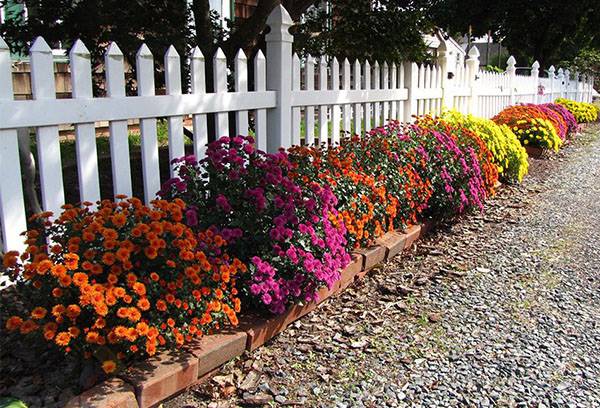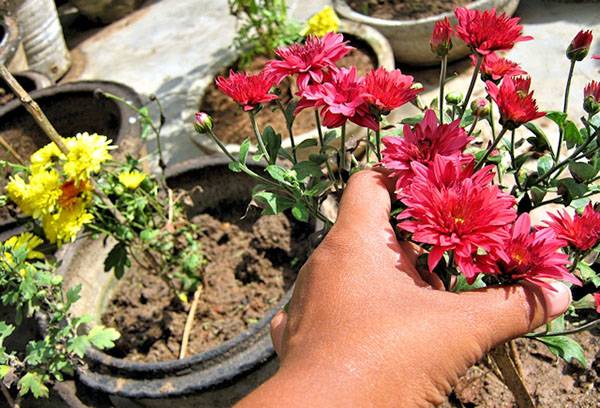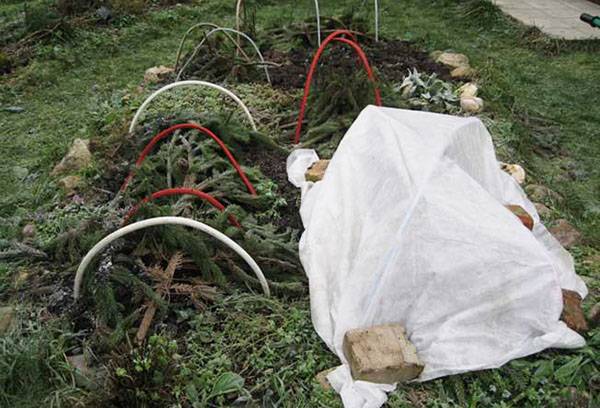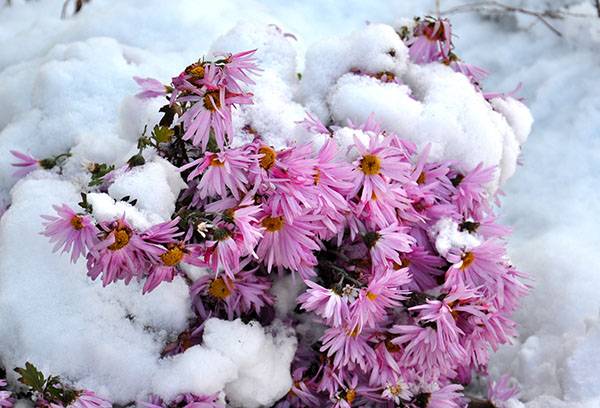Several ways to preserve chrysanthemums in winter
Chrysanthemums are bright, unpretentious flowers that decorate autumn flower beds like summer. Many people root samples from bouquets, plant them on the site and admire them until the first frost. And, of course, everyone wants to preserve chrysanthemums in the winter, so that next summer the bush will delight you with flowers again. There are several methods, the choice of which depends on the variety and the availability of conditions for winter exposure.

Varieties
Released varieties of chrysanthemums can survive the winter in a flowerbed, but there are also those that need to be dug up. These are mainly compact gift bushes or Indian specimens rooted from bouquets. When planted in the ground, the dwarf chrysanthemum will grow, the bush will fall apart, but the flowering will remain. If you leave this variety outside over the winter, it will freeze. Many Indian varieties are also cold intolerant.
If there are no suitable premises for winter storage of chrysanthemums, then it is advisable to purchase cold-resistant species. These include:
- Oak;
- Korean;
- Everest;
- Purple Haze;
- Red Moscow.
The flowers and leaves of these chrysanthemums are smaller, but they are less demanding on climatic conditions and patiently tolerate winter cold.
Advice
Many gardeners believe that in regions with frosty winters, all chrysanthemums need to be dug up for the winter, regardless of their cold resistance. Such bushes grow faster in the spring, hardly get sick and bloom luxuriantly.
Indoor storage
The insulated basement of a private house allows you to solve all problems with the preservation of not only vegetables and preparations, but also flower tubers and rhizomes.
Chrysanthemums should be dug up literally before the first frost. If it’s a little later, it’s not critical. First, all stems are cut to 10 cm. It is better to leave a larger lump of earth. If the floor in the storage is not earthen, then the dug up rhizome is transferred to a box or other container filled with a mixture of sand and peat (1:1). Usually chrysanthemums are left under a canopy until stable frosts, since indoors the rhizomes can begin to grow and begin to lose strength.
The optimal temperature for wintering chrysanthemums in a basement or cellar is from 0 to +4°C, acceptable from -1 to +5°C. If the floor is earthen, then the rhizomes are laid directly on it, fitting them tightly to each other. This way they will not become airy, and natural moisture from the ground is sufficient.
If there is no basement, then the following options are suitable:
- unheated country house or garage;
- veranda;
- good quality barn;
- loggia.
Advice
You should not leave the dug chrysanthemum to overwinter at home. The plant feels the onset of a dormant period. Without adequate daylight and lack of ultraviolet radiation on the windowsill, it will wither and die.
It is advisable to cover chrysanthemum rhizomes stored in country houses, garages or loggias with breathable material. If possible, once a month the containers are slightly moistened (this is especially important for spherical chrysanthemums). If growth appears, it must be cut off.
The main advantage of this method of preserving chrysanthemums is that on the eve of spring you can begin to germinate them.To do this, in early March, the rhizome is transferred to a bright room with a temperature of approximately 15°C. As soon as the sprouts begin to appear, they are carefully separated and transplanted into separate containers.
Outdoor storage
If there is no suitable room, then chrysanthemums can be wintered safely outside. To do this, dig a trench measuring 50*50 or 70*70 cm. The rhizomes are placed tightly on the bottom (stems up), the voids are filled with peat or light soil.
As soon as the temperature reaches sub-zero temperatures, they begin to cover the chrysanthemums.
- The first thin layer should create volume and provide ventilation. Fragments of slate, light reinforcement, and trimming corners are suitable. It is not advisable to use branches to avoid the development of fungus on chrysanthemums.
- The second layer (about 0.5 m) is warming and absorbent. These can be dry leaves (without scab and fungus) or chopped straw.
- The third layer protects the rhizomes of chrysanthemums from precipitation and damping off. A piece of thick film or roofing felt will do. The material is secured along the edges.
In such grooves, chrysanthemums successfully survive until spring. The downside is the inability to control the condition of the rhizomes.
Advice
Prudent summer residents prepare natural covering material throughout the season. This could be grass cut by a lawn mower, straw, pine litter, pine cones, sawdust. All materials are dried and stored until winter.
Some owners of glass or polycarbonate greenhouses use them to store chrysanthemums in winter. The bushes are dug up before frost and transplanted into a greenhouse, where they continue to grow and bloom.After the temperature reaches sub-zero temperatures (about 5-7°C), the stems of chrysanthemums in the greenhouse are trimmed, the bushes are covered with dry mulch and covered with lutrasil. In the spring, they begin to grow quickly and are transferred to the flowerbed already strong.
Wintering in a flowerbed
Cold-resistant garden chrysanthemums even in open ground will not suffer from frost in winter if they are properly prepared in the fall (without digging them up). After the first frost, the stems are cut to 15 cm (young shoots do not need to be touched). It is useful to treat the stumps and the soil around them with a solution of copper sulfate (10 g per 0.5 liter of water) or Bordeaux mixture - this will prevent fungal diseases for the next season. Then the bush hills up slightly. It is important that there are no grooves left where water accumulates.
In the second stage, dry mulch is poured (a layer of 40-50 cm). It is desirable that the mixture contains hard elements (cones, pine needles), which add volume and provide ventilation. You can lay spruce branches or a couple of layers of covering material on top - it will provide air exchange and protect from precipitation.
Some people, after the first frost kills the flowers, simply cut the chrysanthemums in the garden and cover them with spruce branches. It should be noted that pine needles have disinfectant properties, so such a shelter will not provoke a fungal disease.
Preservation by cuttings
If chrysanthemums were purchased in late autumn and it is not possible to winter them in a suitable room, then you can leave the flowers in the apartment. However, there is no guarantee of their safety until spring (even with lighting), so cuttings are used. Plants in pots are placed on the windowsill closer to the window, away from heating. Several cuttings (3-4 cm long) are plucked from the leaf axils.For their rooting, prepare small cups filled with nutritious soil.
The planting technique is simple: a depression is made in the middle of the container, sand is poured into it, moistened, then the cutting is immersed (about 1 cm). The glass is tied with a plastic bag, but loosely, so that ventilation remains. In such a greenhouse, a chrysanthemum cutting usually “sits” for 1-2 months, and then begins to grow. As soon as the roots become visible through the walls of the container or the first leaves appear, the cover is removed. Buds may form, but they are removed immediately. By spring, healthy planting material will be ready.
Chrysanthemums amaze with their varietal diversity, brightness, and original forms. But many are afraid to grow them precisely because of the risk of freezing. Fortunately, it is not difficult to preserve chrysanthemum bushes until the next season, even if there is no suitable premises.


